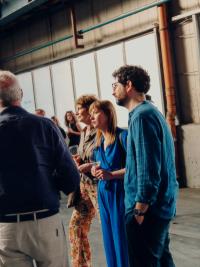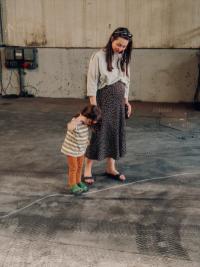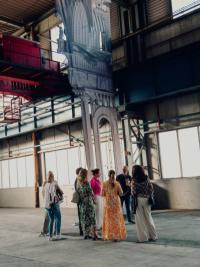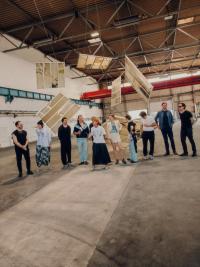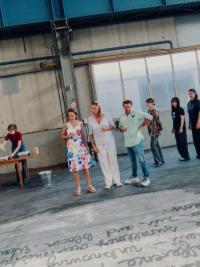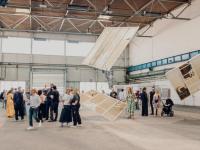
Empty Spaces - Something to believe in
02.05. - 09.05.2025, Building 09
The exhibition project by Empty Spaces e.V. opened up new spaces for young artists for the fourth time. By creatively utilising temporary vacancies, exciting encounters between art and space are created time and again. This time, a vacant hall at the Areal Böhler was transformed into a special exhibition venue. The works on display entered into an exciting dialogue with the industrial architecture and the history of the site. The artists utilised this space to show that art can not only be viewed - here it became a tool for change.
With works by:
X Breidenbach, Cristiana Cott Negoescu, Keta Gavasheli, Gustavo Gomes, Andria Dolidze, Fabio Perino, Moritz Riesenbeck, Lia Sáile, Kai Werner Schmidt, Paul Valentin, Emil Walde
curated by Mara Sporn
X Breidenbach
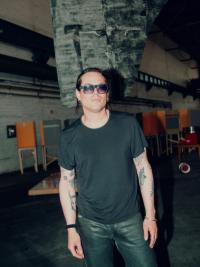

The Space between, 2025
Paper, dust from Hall 09, beeswax, olive oil, bone black and feathers
The work ‘The Space between (Wing Study)’ explores the tension between ascent and collapse as an ephemeral construction made of ephemeral material.
Inspired by the story of Icarus, the work does not attempt to recreate flight, but rather to reveal its anatomy: the impulse, the fragility, the inevitable sinking after the flight altitude has not been maintained. The form is also reminiscent of a wing or an aerofoil. It exists in a state of suspension on the verge of disintegration. The work is not an ‘image of flight’, but a ‘study of faith’ - a fragile theory made of sustainable materials and temporary connections. The materials refer to the mythological sources and at the same time build a bridge to the present.
Cristiana Cott Negoescu
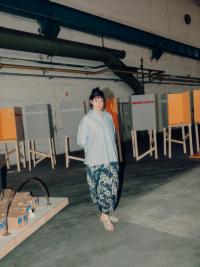
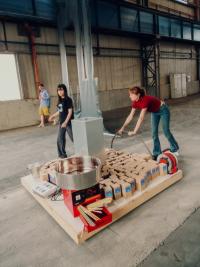
Nominal Value, 2025
Installation set:
9 voting booths - tables and privacy walls - inspired by the ones in the latest Romanian election. Positioned in a 3 by 3 grid.
Dimensions: 80Lx80wcm, 180hcm (with approximation)
1 singled out table, no privacy walls
1 voting ballot
1 cotton candy machine
1 pile of sugar boxes
1 surveillance camera
Performers: Tini Aliman - Ari Behnke Llanos - Rabe Chatha - Bene Rox - Emma Rüther - Eunbi Oh - Gabriela Tudor
This performative installation deals with the complex socio-political issue of voter deception, trust and the exploitation of faith during the election campaign. It critically examines the way in which political parties manipulate citizens in the battle for their votes through promises of material rewards such as sugar, oil and other resources - and yet voters are disappointed, disillusioned and deceived by unfulfilled promises after casting their votes.
Emil Walde

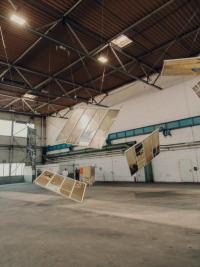
Involuntary Landmark, 2025
The work Involuntary Landmark consists of old windows from Duisburg Central Station. Decoupled from the location, the panes are hung in the exhibition space. The glass has multiple meanings: The transparency for a view through, the separation of inside and outside as protection and boundary, the reflection of light and also the reflection of one's own image and finally it is also its fragility. In the installation, they also symbolise a changing industrial landscape in NRW.
Moritz Riesenbeck

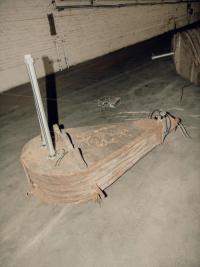
used user (lean), 2025
Bellows (approx. 1800), 2 positions / 3-way solenoid valves and control, double-acting pneumatic cylinders and accessories, CNC engraving
Two 200 year old bellows, now placed in a hall of a former steel construction site, which slowly rise and fall. Fitted with a pneumatic cylinder, as is standard today, they ‘breathe’ in and out again.
These tools from the past once symbolised progress and development in iron and steel production and brought more efficient production processes. Industrialisation brought economic growth on the one hand. On the other hand, it led to environmental and air pollution, uncontrolled consumption of resources and social upheaval, social inequality, urbanisation and the exploitation of workers who had to work in dangerous conditions.
Francisco de Goya (1746-1828) was one of the artists of this period who enlightened the world in his works and etchings; he did not negate the world of ghosts like many of his contemporaries. He shows the abysses of stupidity and brutality of religious and secular power. His depiction of witches torturing small children. One of them is being held by the hands and feet and abused as a bellows. The etching is engraved on a bellows and is vaguely recognisable.
Fabio Perino
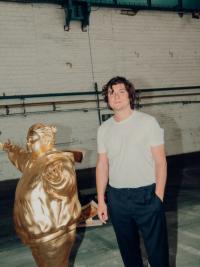
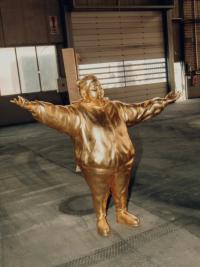
Lifetime Value, 2025
Wood, bread, foam, synthetic resin, gold leaf, variable dimensions
The Roman poet Juvenal (Decimus Iunius Iuvenalis, 59-130 AD) coined the phrase ‘panem et circenses’. It characterised how easily the ‘people’ can be satisfied and manipulated by political or economic rulers. The verb ‘obey’ is written in wooden letters on bread and in the centre is an overweight girl in shining gold. In his work, Fabio Perino confronts the viewer with the question of to what extent and whether a system has the legal, social or philosophical right to define or even manipulate a being. People tend to follow authorities and ideologies without reflecting and sometimes thinking about what corresponds to their own convictions, what they believe in and why they believe it, and to act in this awareness.
Andria Dolidze
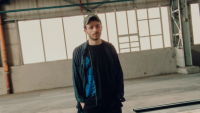
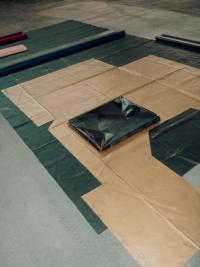
2 2 2 2, 2025
Collected banners, acrylic, oil, metal rings, 530 x 300 cm
2 2 2 2 consists of street banners collected in Düsseldorf that have been stripped of their contents with layers of acrylic. Folded and rolled into a sculptural arrangement, the work reflects both the interior and exterior of the exhibition space, a former metal factory.
Keta Gavasheli
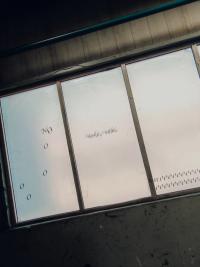
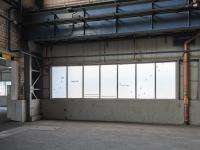
Untitled, 2025
Vinyl letters, plexiglass, 2 m x 6.30 m
The window becomes a sheet of paper, a screen, a threshold. The word fragments of a performance, a memory, a return float across this surface, barely visible, like breath breathed against the glass. The text does not want to be read. To linger here is to agree to not fully comprehend, and perhaps that is the closest we can come to understanding. The words are taken from the final lines of a performance text, a personal reflection on memory, disorientation and the impossibility of a complete return. Scattered letters and sentences fade like half-remembered thoughts. The ‘O’ suggests both an open mouth and an emptiness. As in concrete poetry, the meaning here lies not only in the words, but also in their rhythm. The window holds them like a fragile membrane between presence and absence, between seeing and not seeing.
Paul Valentin
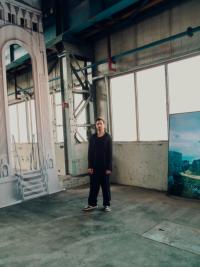
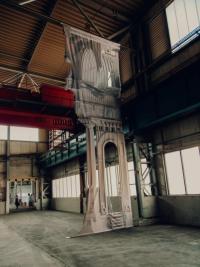
Hendiadyoin, 2025
3D rendering, UV print on blockout, gauze, Aubinol
Video:
Mindfields, 2025
00:06:00 (loop), 4K, 9:16, sound
The work consists of two curtains and a monitor. The curtains come from the baroque theatre, so-called ‘Gassen’. Printed, pasted or painted curtains were used in theatre performances to create a perspectival illusion of nature or architecture on stage. In this work, the curtains represent part of a restored colonnade. In contrast to the theatre, where the spectators are fixed in their seats, here the visitors can vary their position in the hall and create or dissolve the illusion independently.
In the area where the props are traditionally hidden, there is a monitor. A video loop runs on it, showing the rubble of a destroyed bunker facility painted with the symbols of a code. They speak of a deception; a backdrop that has already been destroyed in order to justify a war. But the authors of this code themselves soon no longer know what is true and what is just a façade. For some, the only thing that seems to matter is finding a piece of truth that is not fragile. The scenes are 3D animated (CGI).
Lia Sáile
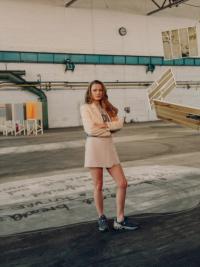
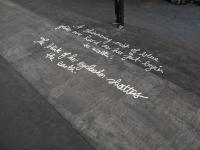
(Re)tracing fragile futures, 2025
Video installation, loop, stereo
A white, oversized patch of colour lies like a forgotten island in the industrial hall. Near and distant stories literally describe the floor, touching, moving, lines traverse the surfaces and form hybrids of word and image. Violets wait trembling in the wind, points of light cause the surface to ripple. Past, present and future are written and drawn across the island's surface. A process of questioning and storytelling unfolds again and again. The recipients are confronted with meditative images and lines that question them about their fears and desires.
Gustavo Gomes
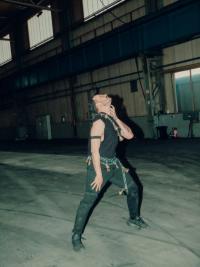
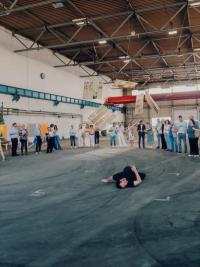
Tintinnabulum, 2025
Performance, duration 30 min
Tintinnabulum is a performance that explores the porous boundaries between masculinity and vulnerability through movement, spoken word and sound. Inspired by the ancient Roman amulet - an erect bronze penis with bells to ward off evil - Gomes revisits this symbol to question softness in a world that demands male toughness. The piece imagines a love story between a stoic soldier and a foreign visitor and traces their evolving connection through trust, tension and devotion. Bells attached to a floating speaker and the performer's body create a soundscape of attraction and friction, enveloping the space in a sensory, shifting environment. Tintinnabulum is a mixture of narrative, history and personal research in Germany, France, Armenia, Georgia and Brazil and is part of Gomes' ongoing documentary film practice. It transforms the stage into a space where sound, sensuality and the politics of masculinity collide, inviting reflection on intimacy, vulnerability and societal expectations. At its core, the project is a study of physical expression, where softness, exposure and full presence become an act of resistance and hope.
Kai Werner Schmidt
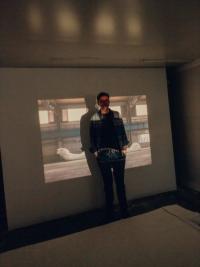
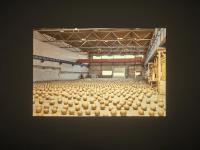
Hall 09, 2025
Installation, slide projector, 40 slides
The work examines the dialectic between the physical exhibition and its visual representation. Kai Werner Schmidt takes his photographs of Halle 09 and, with the help of AI, creates an exhibition from these installations and sculptures. He explores the possibilities and boundaries between human creativity and machine image generation. The AI is not just a tool, but a collaborative partner in a creative, experimental dialogue. In a rhythmic presentation of 40 motifs using a slide projector, analogue tradition merges with digital innovation. It raises the question of authenticity in the digital age, what is real and what is deepfake. In ‘The Reconfigured Eye’, a standard work on this subject, the architect and media theorist William John Mitchell remarked in 1992 that digitalisation was leading to a ‘de-realisation of the photographic world’.
